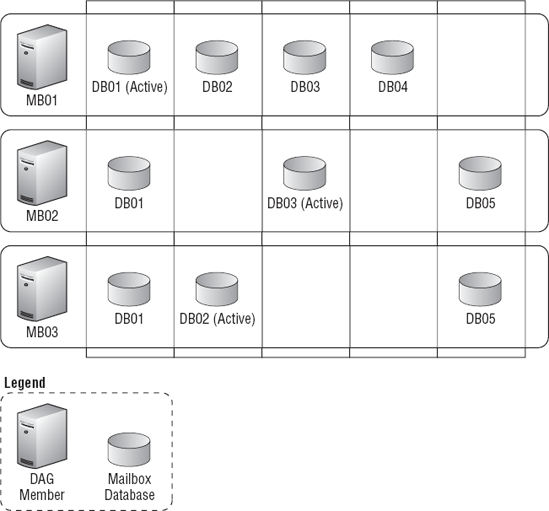2. Increase Mailbox Database Availability
One of the primary areas of
focus for keeping a high degree of availability is the data that each
user stores in their mailbox. Maximizing mailbox database availability
is one of the most difficult challenges in managing Exchange. The
capabilities around database availability have changed from one Exchange
version to the next, with each method becoming increasingly more
effective. This section helps you understand how to maintain high levels
of availability for your mailbox databases in Exchange Server 2010.
2.1. Understand Database Availability Options
The options for database
availability have changed in Exchange Server 2010. In previous versions
of Exchange, you had the ability to cluster mailbox servers in order to
keep mailbox databases highly available. In Exchange Server 2007,
continuous replication was introduced, which provided database
availability by copying the transaction logs from an active database to a
passive copy of the same database.
Exchange 2010 further expands on
the continuous replication technology and provides a single database
availability solution that fits every common scenario. This technology
is referred to as a database availability group (DAG).
2.1.1. Understand the Basics of DAGs
A DAG is a collection of
Mailbox servers (up to 16 servers) that can share copies of the same
mailbox databases. One server in the DAG holds the active copy of the
database, and one or more other servers can contain passive copies of
the same database. The databases are kept synchronized using the
continuous replication log shipping method that was used in Exchange
Server 2007. There are many advantages to the DAG approach:
Databases can be hosted on any of the Mailbox servers in the DAG.
Mailbox servers in a DAG can also perform other Exchange roles.
Recovery from a database failure is automatic.
Mailbox servers in a DAG can live in different sites.
DAGs
use Windows Failover Clustering in the back end, but all configuration
and administration is performed through the Exchange tools.
Failover occurs within 30 seconds.
Figure 6 shows how a DAG configuration might look.

In this example, there
are three Mailbox servers and five databases that are replicated between
the mailbox servers in the DAG. Only one server has an active copy of
the database. As you can see in the figure, the database can be
selectively replicated to other servers. Each server is not required to
host a replica of every database. This offers great flexibility in
designing your database availability solution.
2.1.2. Determine How Databases Fail Over
When the active
copy of a replicated database fails, how does Exchange determine which
passive copy gets activated? This process is determined by a component
called the Active Manager. The Active Manager has two roles:
The Primary Active
Manager (PAM) is hosted on one of the servers in the DAG. The PAM
determines which copy of the databases should be active.
The
Standby Active Manager (SAM) is hosted on the remaining Mailbox servers
in the DAG. The SAM keeps tabs on the databases running on the Mailbox
server and notifies the PAM when a database fails. The SAM also informs
Hub Transport servers and Client Access servers about which server hosts
the active copy of a database.
When a database failure
occurs, the Active Manager looks at the health of the passive copies of
the databases to determine which copies should be targeted for failover.
In making its determination, the Active Manager looks at the database
copy status, the health of the content index, and the length of the log
copy queue and the log replay queue.
If multiple passive copies
of the database meet the Active Manager's criteria list, the database
with the lowest Activation Preference setting is activated. The
activation preference order is determined by you when you add database
copies to other Mailbox servers in a DAG.
2.2. Implement Database Availability Groups
To implement DAGs, use the following steps:
Configure the network adapters on the mailbox servers that will be in the DAG.
Every
mailbox server in the DAG must have two adapters installed. One adapter
will be for clients to access the data in the mailbox stores (MAPI
traffic), and the other adapter will be used for data replication
between DAG members. These two adapters must be on different subnets and
the subnets must map to networks that are assigned to the DAG.
Add
members to the DAG. Up to 16 members can be added. When a member is in
the DAG, it can host copies of databases from any other member in the
DAG.
Create
some mailbox databases. If you don't already have a mailbox database on
one of your Mailbox servers in the DAG, go ahead and create some.
Add
a copy of a mailbox database in a DAG to another server in the DAG. Now
that you have multiple servers in your DAG and at least one database,
you can enable that database to be copied to other servers.